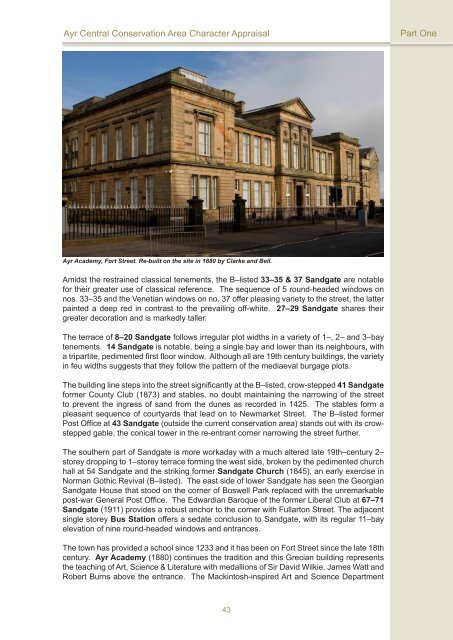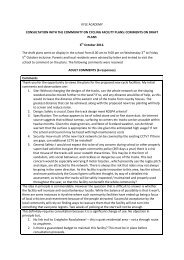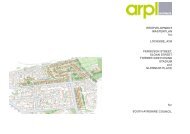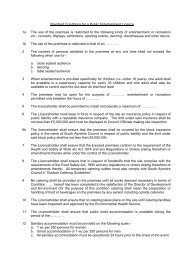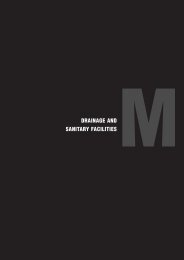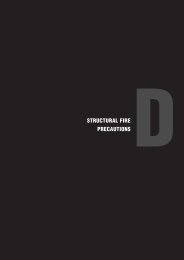Ayr Central Conservation Area Character Appraisal - South Ayrshire ...
Ayr Central Conservation Area Character Appraisal - South Ayrshire ...
Ayr Central Conservation Area Character Appraisal - South Ayrshire ...
Create successful ePaper yourself
Turn your PDF publications into a flip-book with our unique Google optimized e-Paper software.
<strong>Ayr</strong> <strong>Central</strong> <strong>Conservation</strong> <strong>Area</strong> <strong>Character</strong> <strong>Appraisal</strong><br />
Part One<br />
<strong>Ayr</strong> Academy, Fort Street. Re-built on the site in 1880 by Clarke and Bell.<br />
Amidst the restrained classical tenements, the B–listed 33–35 & 37 Sandgate are notable<br />
for their greater use of classical reference. The sequence of 5 round-headed windows on<br />
nos. 33–35 and the Venetian windows on no. 37 offer pleasing variety to the street, the latter<br />
painted a deep red in contrast to the prevailing off-white. 27–29 Sandgate shares their<br />
greater decoration and is markedly taller.<br />
The terrace of 8–20 Sandgate follows irregular plot widths in a variety of 1–, 2– and 3–bay<br />
tenements. 14 Sandgate is notable, being a single bay and lower than its neighbours, with<br />
a tripartite, pedimented first floor window. Although all are 19th century buildings, the variety<br />
in feu widths suggests that they follow the pattern of the mediaeval burgage plots.<br />
The building line steps into the street significantly at the B–listed, crow-stepped 41 Sandgate<br />
former County Club (1873) and stables, no doubt maintaining the narrowing of the street<br />
to prevent the ingress of sand from the dunes as recorded in 1425. The stables form a<br />
pleasant sequence of courtyards that lead on to Newmarket Street. The B–listed former<br />
Post Office at 43 Sandgate (outside the current conservation area) stands out with its crowstepped<br />
gable, the conical tower in the re-entrant corner narrowing the street further.<br />
The southern part of Sandgate is more workaday with a much altered late 19th–century 2–<br />
storey dropping to 1–storey terrace forming the west side, broken by the pedimented church<br />
hall at 54 Sandgate and the striking former Sandgate Church (1845), an early exercise in<br />
Norman Gothic Revival (B–listed). The east side of lower Sandgate has seen the Georgian<br />
Sandgate House that stood on the corner of Boswell Park replaced with the unremarkable<br />
post-war General Post Office. The Edwardian Baroque of the former Liberal Club at 67–71<br />
Sandgate (1911) provides a robust anchor to the corner with Fullarton Street. The adjacent<br />
single storey Bus Station offers a sedate conclusion to Sandgate, with its regular 11–bay<br />
elevation of nine round-headed windows and entrances.<br />
The town has provided a school since 1233 and it has been on Fort Street since the late 18th<br />
century. <strong>Ayr</strong> Academy (1880) continues the tradition and this Grecian building represents<br />
the teaching of Art, Science & Literature with medallions of Sir David Wilkie, James Watt and<br />
Robert Burns above the entrance. The Mackintosh-inspired Art and Science Department<br />
43


